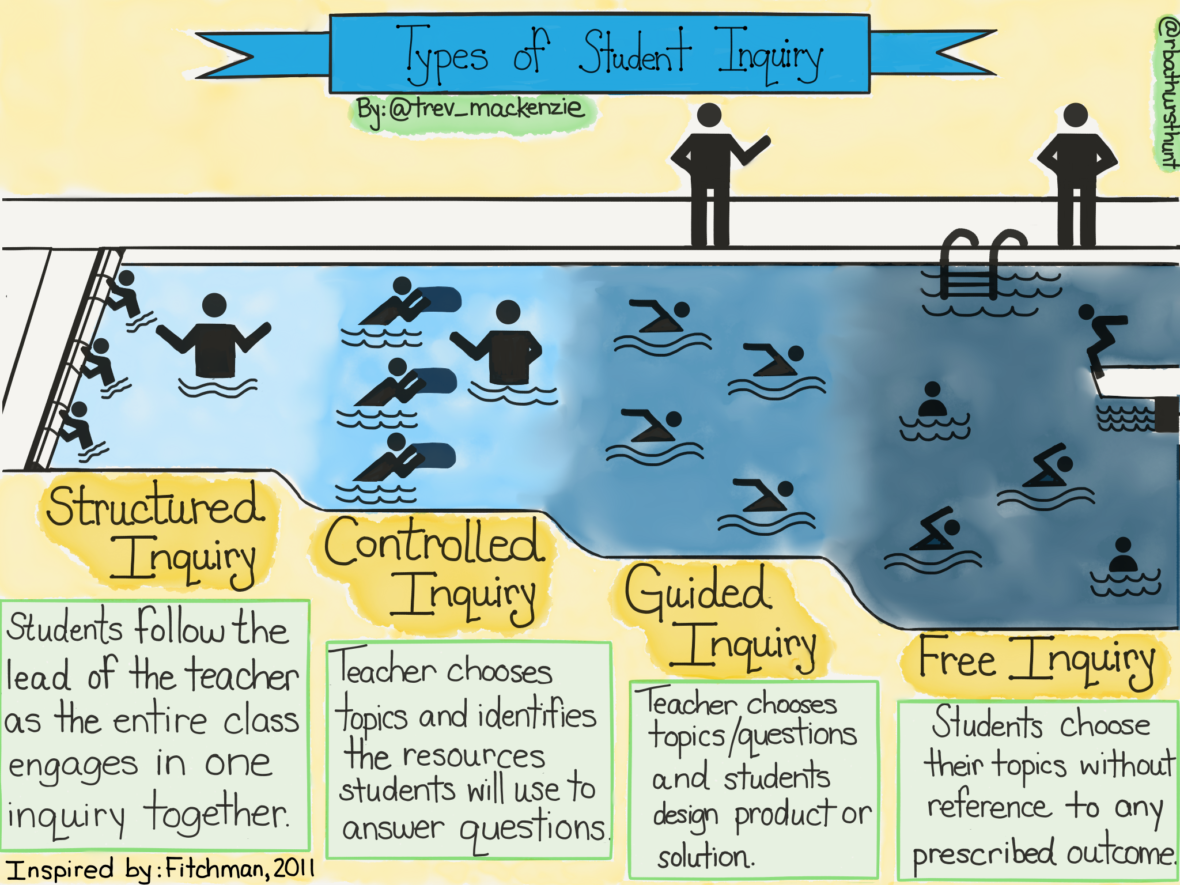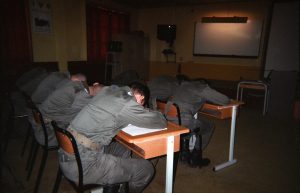Regarding Inquiry / Problem-Based Learning:
Trevor Mackenzie’s (@trev_mackenzie) discussion around implementing Inquiry in the classroom was something I’ve been introduced to in my teaching PDP program. The concept was one that I had intended weave into my courses for the new school year. While that was the plan, I admit I did have concerns with the level of depth versus breadth I should design. This is where Trevor framing the Inquiry process as a swimming pool gave me the inspirational nudge I needed (into the pool).

It was helpful in clarifying that I shouldn’t fill the course with just “Free Inquiry” projects; that repeatedly tossing them into deep end will help them swim.

I believe my approach would be valid if, and only if, students have had prior experience with the Inquiry model or had I taught them previously (which is unlikely as this is still in development). The scaffolding design is ideal as I could re-arrange units with more abstract concepts, or those I predict students to have a difficult time with, to have “Structured Inquiry”. Meanwhile, easier units can use Free Inquiry format to help students find their own interests and curiosities. With that in mind, my remaining worry is how apply this model into content-laden courses such as Biology 12, where it’s largely based on brute-force memorization.

On another thread regarding Inquiry, I was delighted to learn about Jeff Hopkins’ (@hopkinsjeff) Pacific School of Innovation and Inquiry which implements a student driven, open inquiry model program for grades 9 through 12. To be precise, the knowledge that my colleagues and I who are interested in introducing cross-curricular inquiry have an example to draw from; as well as a place to visit for Pro-D days. I fully agree with Jeff’s observation that learning as kids and as adults due to simple curiosity is much more effective than the forced factory-mandated process of learning prescribed content we see occurring in traditional schools. It would make more sense to consistently apply that approach through K-12 and into post-secondary (latter is debatable), rather than having them forget and have to re-learn how to pursue their passion.
While this shift would undoubtedly be a long and difficult process, as active teachers have precious little time to learn and consider how to overhaul their practices, we luckily have schools willing to act as experimental trials for the rest of the province. As Jeff himself mentioned, he wanted his school to be the template for other district or public schools to model after.

I believe the school I’m working at would be able to implement cross-curricular inquiry in our academic classes. First, we are a choice school where a large proportion of our students find the traditional classroom challenging; so this alternative would work much better for them. Secondly, we offer Blended and Online courses so our students have a lot of independent study time throughout the week where they are not (completely) restricted to the same pace as their classmates. Lastly, we have small class and staff size. Small class sizes allows us to feasibly build relations with each student and provide individual guidance, whilst limiting the increase in time spent marking within manageable levels (major downside to not using scantrons). Few staff members means each department only has 1 or 2 teachers so it’s not a huge undertaking for the departments to collaborate across curricula, or worry that different teachers teaching the same course are using different pedagogies. We’ve already come up with potential cross-curricular inquiry with my favourite so far being between Foods and Biology (mine is: what are the effects & ideal time to salt and dry fish before cooking?)

This week was also inspiring in my understanding and application of Indigenous ways of knowing into my classes. The two big focus points in my PDP program were incorporation of Inquiry / Problem-Based-Learning (PBL) and Aboriginal Education (AbEd) as part of Ministry requirements. My initial feelings was to just have them teach me how to teach first, which Shauneen Pete pointed out in her book, was the common response of in-service teachers’ aversion to widening their perspective on teaching. So in taking a step away from the standard Eurocentric pedagogy, I came to realize that I already deviated from those practices and have included aspects of Indigenous pedagogy. Things such as building relations with students and letting them influence some direction of class are prime examples of this, as opposed to the content-focused methodology where the teacher holds all the power. In re-framing the adjustments we make to help students succeed, we are effectively promoting Indigenous ways of knowing already.




